Travoprost
Uses of Travoprost
- Travoprost is primarily used to treat elevated intraocular pressure (IOP) in patients with open-angle glaucoma or ocular hypertension. As a prostaglandin analogue, it helps reduce IOP, preventing potential vision loss associated with these conditions.
- The medication is specifically designed to manage high eye pressure, which can lead to pain or changes in vision. There are no significant secondary uses for Travoprost, as it is solely indicated for managing IOP in glaucoma and ocular hypertension.
Side effects of Travoprost
Ocular hyperaemia (redness)
Eye discomfort or pain
Foreign body sensation
Increased pigmentation of the iris and eyelashes
Eyelash growth and thickening
How Travoprost works
Travoprost is a prostaglandin analogue, which is a type of medication used to manage eye conditions.
It functions by mimicking the actions of naturally occurring prostaglandins in the body which help to regulate the flow of eye fluid.
Specifically, Travoprost works by improving the outflow of aqueous humour, a clear fluid that fills the space between the lens and the cornea in our eyes, through a pathway known as the uveoscleral route.
By increasing this drainage of fluid from the eye, it reduces high intraocular pressure (IOP). This is beneficial in managing conditions like open-angle glaucoma and ocular hypertension where impaired fluid drainage causes elevated IOP.
In these conditions, reducing IOP can help prevent optic nerve damage and potential vision loss.
Certified content
Written By

MSc (Applied Genetics)
Reviewed By

BMS, FMC, MD Resident
Expert Advice
Dosage Forms Available
Travoprost is available as a sterile ophthalmic solution to be administered via the ocular route, directly into the eye.
Age and Dose Restrictions
This medicine is indicated for use in adults and children over the age of 16 years.
Contraindications
Travoprost is contraindicated in patients with known hypersensitivity to any of its components.
It is also contraindicated in patients with active intraocular inflammation.
Other Medications to Avoid
Travoprost may interact with other topical ophthalmic prostaglandin analogues (e.g., latanoprost, bimatoprost).
Before starting any other prescription or over-the-counter medications, it is crucial to consult your doctor as using other IOP-lowering medicines with Travoprost needs careful consideration.
Overdose and Missed Dose
In case you happen to put a few extra drops of this medicine in your eye, do not panic. Rinse your eyes with clean water at room temperature. If any symptoms persist such as redness, discomfort or pain in the eye worsen, inform your doctor immediately.
If you forget a dose, administer it as soon as you remember. However, if it is close to the time for the next dose, skip the missed one and resume your regular dosing schedule.
Management of Side Effects
Most side effects are temporary and generally harmless and resolve when discontinuing this medicine. However, if you experience any severe side effects or worsening of any of the symptoms, please consult your doctor.
For eye discomfort or foreign body sensation, try closing your eyes and gently massaging your eyelids.
For dry eyes, use a humidifier in your environment or use over-the-counter artificial tear solutions.
For eye redness or irritation, use a cold compress on the eyes for temporary relief.
Use in Driving and Operating Machinery
Travoprost may cause mild visual disturbances such as blurred vision. If affected, avoid driving or operating heavy machinery until your vision is clear.
Use in Pregnancy and Lactation
Travoprost is classified as pregnancy category C, hence it should be used during pregnancy only if the potential benefit justifies the potential risk to the foetus. Always consult your doctor before using this medication during pregnancy.
It is not known whether Travoprost is excreted in human breast milk. Therefore, it should be used with caution in breastfeeding mothers and only is prescribed by your doctor.
Caution in Other Conditions
Patients with risk factors for macular oedema should exercise caution when using Travoprost.
Patients with torn posterior lens capsules should also be cautious while using this medicine.
Special Dietary and Lifestyle Recommendations
Regular eye check-ups are crucial to monitor the progress and effectiveness of the treatment.
Avoid smoking and limit the consumption of alcohol as these can increase intraocular pressure.
Wearing sunglasses and hats when outside can help protect your eyes from sun damage.
Ensure good hygiene while handling the ophthalmic solution to avoid contamination and potential infections.
Maintain a balanced diet rich in vitamins A, C, E, and minerals like Copper and Zinc that are essential for eye health.
Frequently asked questions
Is Travoprost a steroid?
No, Travoprost is not a steroid. It is a prostaglandin analogue, specifically used for managing elevated intraocular pressure in conditions like open-angle glaucoma or ocular hypertension.
Does Travoprost have any effect on sleep?
There is no evidence to suggest that Travoprost has any direct impact on sleep patterns. However, if you experience any unusual symptoms such as difficulty in sleeping, you should consult your doctor immediately.
Will Travoprost affect fertility?
There is no conclusive research suggesting that Travoprost affects fertility in men or women. However, it's always advisable to discuss any concerns related to fertility with your doctor before starting this medication.
Are there any particular diet restrictions while taking Travoprost?
There are no specific dietary restrictions for patients using Travoprost. You should continue to follow a balanced and healthy diet unless advised otherwise by your doctor.
Is it safe to take Travoprost daily?
Yes, it is usually safe to use Travoprost daily as prescribed by the doctor. Do not use this medication beyond the duration specified. Consult with your doctor for any further concerns.
How much time does Travoprost take to work?
Travoprost starts reducing the intraocular pressure within 2 hours of administration, with maximum effect typically observed after 12 hours.
What is the best time to take Travoprost?
Travoprost is usually advised to be taken once daily, preferably in the evening. It's best to follow your doctor's instructions regarding the dosing schedule.
Travoprost in other salts
List of Medicines for Travoprost


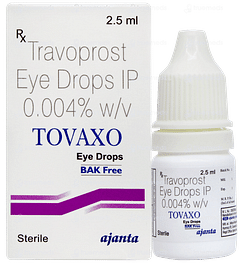
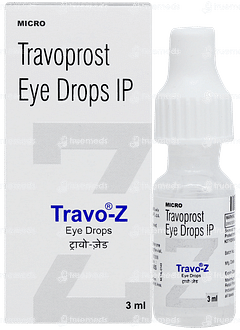
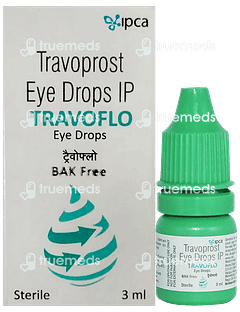
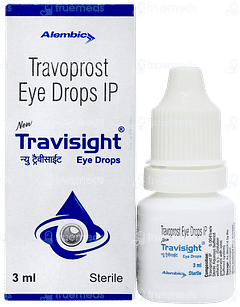

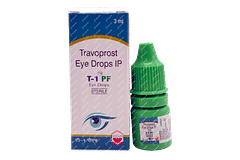
Company
About UsHealth ArticleHealth StoriesDiseases & Health ConditionsAll MedicinesAll BrandsNeed HelpFAQSubscribe
Registered Office Address
Grievance Officer
Download Truemeds

Contact Us
Our customer representative team is available 7 days a week from 9 am - 9 pm.
v3.7.8
Our Payment Partners








